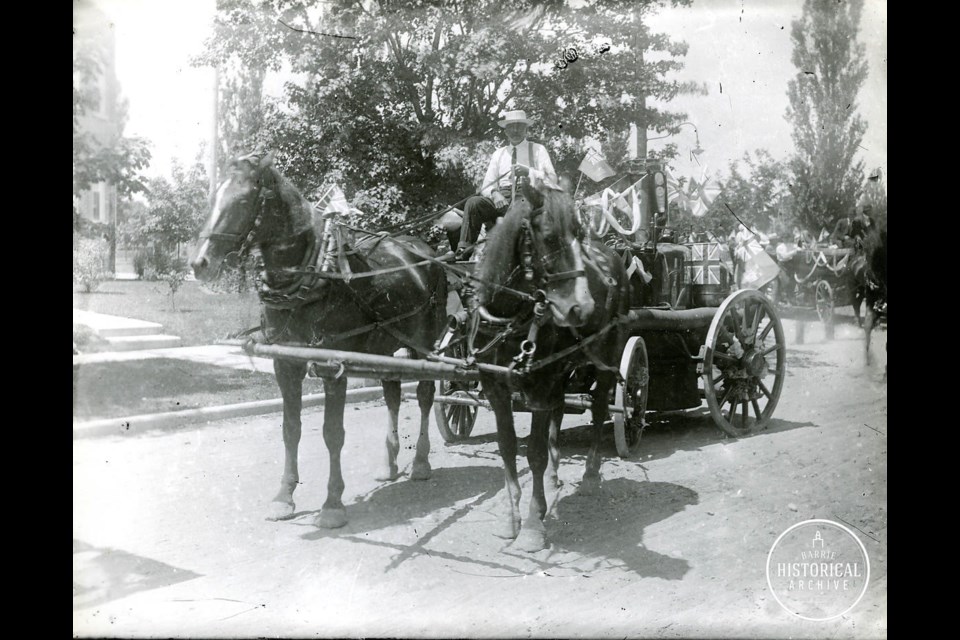In the early years in Barrie, the fire brigade fought two adversaries – the flames that constantly threatened the wood frame buildings and the ongoing lack of support from the community. The local government was hesitant to spend money on something that ‘might’ happen, yet when the inevitable occurred it was the fire brigade that got the blame when property was lost.
So little consideration was given to the equipping of the fire brigade that the apparatus was housed in a glorified shed behind the Market Building, where the water supply came from several cisterns that were never kept full, and often froze over during cold weather.
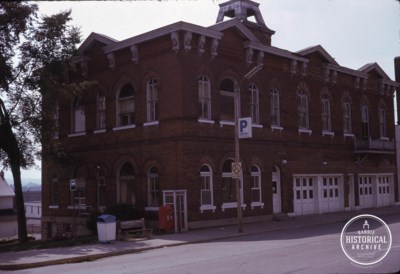 Fire hall built in 1875 on Collier St. at Mulcaster St. in 1974. Photo courtesy of the Barrie Historical Archive.
Fire hall built in 1875 on Collier St. at Mulcaster St. in 1974. Photo courtesy of the Barrie Historical Archive. In 1865, a proper fire house of bricks and mortar was built, complete with heated storage, on the southwest corner of Collier and Mulcaster Streets. Still, a fair bit of grumbling went on about the expense and plenty of letters to the editor appeared in local papers. In December 1866, a writer for the ‘Barrie Examiner’ wondered if “fourteen hundred dollars for a Fire Hall” was really justifiable.
Despite these improvements, the firemen of nineteenth century Barrie laboured under some pretty primitive conditions. Even though horses were common in Barrie, they pulled everything but fire equipment. It was not considered ‘manly’ for a firefighter to allow a beast to pull the fire engines because that was his job!
On January 30, 1873, a fire broke out in a shop among the roughcast buildings that made up the Boys’ Block, which ran from Mulcaster St. to the Post Office Square, on the south side of Dunlop St. E. The fire alarm was raised but it became apparent that it could not be heard everywhere.
“Our Fire Brigade were on hand with great promptitude, and did all that could be done to stop the progress of the devouring element, when we take into account the fact that, owing to the feeble tone of our Town Bell, the second engineer did not arrive on the scene of action until nearly all was over.” – ‘Northern Advance’, February 6, 1873
The Boys’ Block was largely reduced to ashes. Several shop owners removed what goods they could salvage and set up temporary storefronts in the Morrow Block just up the hill on Collier St. If they had some idea that they would find safety as neighbours of the fire hall, they were wrong. Only one week later, the ‘Northern Advance’ had another fire story to cover.
“The steam engine, which was in such requisition last week, had sustained injuries which rendered it necessary that a part thereof be sent to Toronto for repairs.” Whether the shops would have been razed even with the extra machine power is anyone’s guess but the fire removed this block from the Barrie map as well.
To make the insult complete, the destruction included the fire hall itself.
“In the meantime, the flames were devouring all within their reach to the east, and in a comparatively short time, the alarm ceased to ring in consequence of the Fire Hall being in flames, for which, with the adjoining Tower, it was quickly seen there was no hope.”
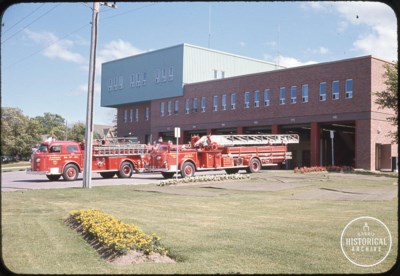 Fire hall and police station on Vespra St. circa 1975. Photo courtesy of the Barrie Historical Archive.
Fire hall and police station on Vespra St. circa 1975. Photo courtesy of the Barrie Historical Archive. An inquest was held within a week and the jury returned six findings with the last one stating “That this Jury are of the opinion that the Fire Organization of the Town is, at present, in a most unsatisfactory state, and would earnestly ask the Town Council to take prompt and energetic action, in order to place the Fire Department in an efficient condition.”
It was not for the lack of will on the part of the firemen that these losses occurred. They did the best they could given the circumstances and the supplies they had to work with. Out of the depressing situation, came a tale of extreme dedication. Mr. Keenan, first engineer with the Barrie Fire Brigade, lived above the doomed fire house but left all his belongings to assist in the battle, and then went to the extreme length of manually pulling the 4,400-pound ‘steamer’ out of the building himself to save it. All his possessions were lost to the fire.
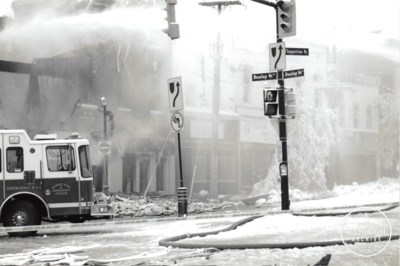 Water and smoke during the Wellington Hotel fire in 2007. Photo courtesy of the Barrie Historical Archive.
Water and smoke during the Wellington Hotel fire in 2007. Photo courtesy of the Barrie Historical Archive. With the fire hall, only 8 years old, destroyed, the debate began in earnest again about the burden of financing another structure. It was suggested that selling the bricks of the ruin to the burned-out shop keepers, for their rebuilding efforts, at half price might be a way to gather some funds.
Finally, in 1875, the longest-standing of all the
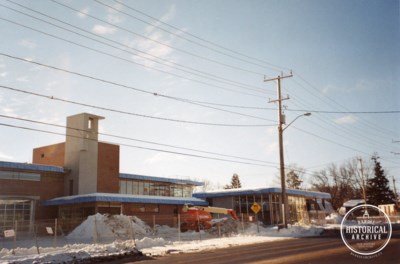 New fire hall under construction at Dunlop W. and Eccles Sts. in 2011. Photo courtesy of the Barrie Historical Archive.
New fire hall under construction at Dunlop W. and Eccles Sts. in 2011. Photo courtesy of the Barrie Historical Archive. Barrie fire halls opened on the same corner as the one lost two years prior. The rebuild cost $4,000. The new station was very well equipped for the time with a proper fire pole, good horse stables, decent living quarters for the men, hose drying tower and a decent bell obtained from a brewery in Toronto.
This hall served Barrie for 103 years until it was torn down, despite much protest, in 1978. After vacating the Collier St. hall, until the latest Downtown fire hall was built on the site of the old Dunlop Arena, the fire station occupied a building on Vespra St.
